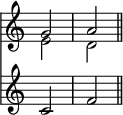is not formed, and there remains, therefore, nothing to be condemned.
The answer to this objection is twofold. In the first place, the impression left on the ear by Hidden Fifths or Octaves is sometimes almost as strongly marked as that produced by real ones; the ear itself possessing the faculty of filling up the leaps, in imagination, when tempted to do so by the nature of the progression submitted to it. Secondly, in unaccompanied vocal music to which the prohibition most particularly refers the least tendency on the part of an incautious singer to bridge over the leap by means of a portamento would instantly produce the effect indicated in the above example.
Nevertheless, the law against Hidden Fifths and Octaves is not an inelastic one. It is true, that, in two-part counterpoint, they are as sternly condemned as the most glaring sequence of real Fifths. Even in three parts their presence is scarcely tolerated. But, in four or more parts, they are only to be reprehended under certain conditions. For instance, between the extreme parts they should only be used as a means of escape from some serious difficulty. Between one extreme and one mean part they are considered less objectionable. Between two mean parts there is little to be said against them; and, when one of the parts concerned in their formation moves a semitone, they are freely permitted, even between treble and bass. Bearing these rules in mind, the student can scarcely go very far wrong; and, should he find any difficulty in detecting the faulty progressions, it may be removed by a reference to the old law, which enacts that 'A Perfect Concord may not be approached in similar motion.'
The great masters of the 16th century were far more lenient towards Hidden Fifths and Octaves than many modern theorists. In the works of Palestrina and his contemporaries, examples, even between extreme parts, may be found on almost every page.[1] These composers also delighted in hiding Fifths and Octaves in another and a singularly beautiful way. It is of course understood that such progressions are only forbidden when they occur between the same two parts. When formed between different voices, by means of crossing the parts, they are perfectly lawful; as in the following combinations from Palestrina's 'Missa Papae Marcelli' and 'Missa Brevis':
 |
 |
The effect of such passages as these, when sung without accompaniment, is perfectly pure and beautiful; but when arranged for keyed instruments, where the motion of the parts cannot be distinguished, they become simply intolerable.
 |
 |
In this form they degenerate into sequences of the most vulgar character; but this is not the form in which Palestrina intended them to be heard.
HIGHLAND FLING. A step in dancing, peculiar to the Scotch Highlands. The name is commonly transferred to the dance itself. The term 'fling' expresses the kicking gesture which characterises it. When a horse kicks by merely raising one leg and striking with it, he is said, in grooms' parlance, to 'fling like a cow.' The performer dances on each leg alternately, and flings the other leg in front and behind. The Highland Fling, in which three, four, or more persons may take part, is danced to the music of the Strathspey. The following is a specimen:—
Marquis of Huntly's Highland Fling.

HIGH MASS (Lat. Missa Solemnis; Fr. Grand-messe; Germ. Grosse Messe). Mass, sung throughout, with full Ceremonial, the Priest being assisted by Deacon and Subdeacon, Master of Ceremonies, Thurifer and two Acolyths. A Mass, sung with equally solemn music, but without the assistance of a Deacon and Subdeacon, and without the use of Incense, is called a Missa cantata, or Sung Mass.
Low Mass is said by the Priest, without music, and with the assistance of one Server only. [See Mass.]
HILL, W., & SON are organ builders in London. The house was founded by John Snetzler about I755 who was succeeded in 1780 by his foreman, Ohrmann. [Snetzler.] The latter had a partner, W. Nutt, in 1 790, who was afterwards joined by Thomas Elliott about 1803. After Elliott had done business for some time alone, he took as partner, in 1825, William Hill, a Lincolnshire man, who had married his daughter, and died in 1832, Hill remaining alone until 1837, when he was joined by Frederic Davison. After 1838 Davison left to become a partner of John Gray, and the firm became W. Hill & Son. [Gray & Davison.] Hill died Dec. 18, 1870. He deserves the gratitude of English organists fo having, in conjunction with Gauntlett, introduced the CC compass into this country.
- ↑ In the beginning of Palestrina's motet 'Fratres ego' there is indeed an instance of Hidden Fifths, In two parts; but this case is so extraordinary that the writer cannot remember ever having met with a parallel one.
